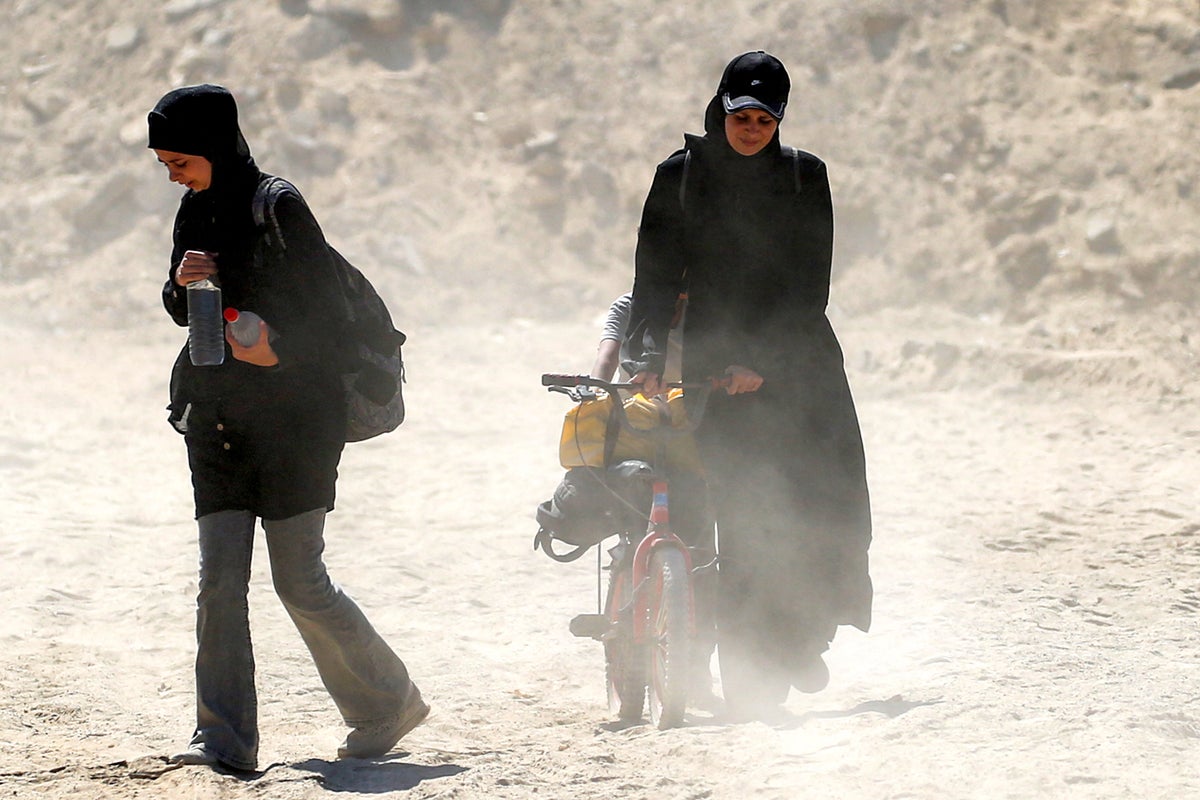Politics
Thousands of Palestinians Return Home After Ceasefire Agreement

Tens of thousands of Palestinians began returning to their homes in Gaza on Friday, following a ceasefire agreement between Hamas and Israel. This marked a significant moment for many who have faced displacement and destruction over the past two years due to escalating violence.
As people walked along the coastal road to Gaza City, they carried minimal belongings, often just a small rucksack or a metal container for water. Many had been displaced multiple times during the ongoing conflict, and the sight of devastated neighborhoods and ruined buildings served as a stark reminder of the violence they had endured. Among those making the journey was Mahmoud Al-Kafarneh, a 37-year-old man heading back to North Gaza after living in a tent for an extended period. “Your body shivers from the scale of the destruction,” he remarked. He expressed a mix of joy and relief at the cessation of shelling, hoping the ceasefire might become a lasting peace.
The mass movement of people commenced shortly after midday when the Israeli government officially declared the ceasefire began. Under the terms of the agreement, Hamas is required to release 48 hostages, with 20 of them believed to be alive, who were taken during the attacks on October 7, 2023. In exchange, Israel will release 2,000 Palestinians currently held in Israeli prisons. An official from Israel indicated that the handover of hostages might begin as soon as Sunday.
Israeli forces are expected to withdraw from certain populated areas, retreating to what is known as the “yellow line,” which is several kilometers deep into Gaza. This strategic pullback aims to minimize civilian casualties, although the situation remains precarious. The official stated that while all hostages are meant to be released simultaneously, logistical challenges might delay their return, given that Hamas may not know the whereabouts of all the deceased captives.
In light of the ceasefire, Donald Trump plans to visit Israel next week to discuss the situation with government officials and meet with families of the hostages. His involvement underscores the international dimension of the crisis, as negotiations continue to involve regional players such as Qatar and Turkey, who are expected to assist in locating missing individuals.
As the enclave opens up, humanitarian organizations have raised urgent calls for the lifting of restrictions on aid deliveries. UNICEF spokesperson Ricardo Pires highlighted the dire conditions faced by children in Gaza, who have been deprived of essential nutrition for prolonged periods. “The situation is critical. We risk seeing a massive spike in child deaths,” he warned, emphasizing that the vulnerable population requires immediate assistance.
In areas such as Khan Younis, returning residents encountered scenes of devastation, with many finding their homes reduced to rubble. “There was nothing left. Just a few clothes, pieces of wood, and pots,” said Fatma Radwan, reflecting the overwhelming loss experienced by many. Another displaced individual, Hani Omran, described returning to an unrecognizable town where destruction was pervasive.
In Tel Aviv, families gathered in Hostages Square to await news of their loved ones. Emotions ran high as they celebrated the ceasefire while remaining cautious. Einav Zangauker, mother of hostage Matan Zangauker, called for unity among the Israeli public to support the continuation of the ceasefire, stating, “We are in days when we need you more than ever.”
Those with loved ones still in captivity expressed a mix of hope and anxiety. Arbel Yehoud, a previous hostage, shared her emotional plea for her partner Ariel Cunio, who remains in captivity. “Just a little longer and you’ll be home, my beloved,” she said tearfully. Meanwhile, Omri Lifhshitz, whose father Oded was killed in captivity, described the ongoing uncertainty faced by families waiting for news. “This feels like the end of the war. I hope this will be better for all of us,” he remarked, reflecting on the desperate hope for a brighter future in Gaza.
As the ceasefire holds, the path toward lasting peace remains fraught with challenges. Israeli Prime Minister Benjamin Netanyahu has reiterated that military operations will persist until Hamas disarms fully. He stated, “If this is achieved the easy way – so be it. If not – it will be achieved the hard way.” The coming days will be critical in determining whether this ceasefire can evolve into a more enduring resolution to the ongoing conflict.
-

 Health3 months ago
Health3 months agoNeurologist Warns Excessive Use of Supplements Can Harm Brain
-

 Health3 months ago
Health3 months agoFiona Phillips’ Husband Shares Heartfelt Update on Her Alzheimer’s Journey
-

 Science2 months ago
Science2 months agoBrian Cox Addresses Claims of Alien Probe in 3I/ATLAS Discovery
-

 Science2 months ago
Science2 months agoNASA Investigates Unusual Comet 3I/ATLAS; New Findings Emerge
-

 Science1 month ago
Science1 month agoScientists Examine 3I/ATLAS: Alien Artifact or Cosmic Oddity?
-

 Entertainment5 months ago
Entertainment5 months agoKerry Katona Discusses Future Baby Plans and Brian McFadden’s Wedding
-

 Science1 month ago
Science1 month agoNASA Investigates Speedy Object 3I/ATLAS, Sparking Speculation
-

 Entertainment4 months ago
Entertainment4 months agoEmmerdale Faces Tension as Dylan and April’s Lives Hang in the Balance
-

 World3 months ago
World3 months agoCole Palmer’s Cryptic Message to Kobbie Mainoo Following Loan Talks
-

 Science1 month ago
Science1 month agoNASA Scientists Explore Origins of 3I/ATLAS, a Fast-Moving Visitor
-

 Entertainment2 months ago
Entertainment2 months agoLewis Cope Addresses Accusations of Dance Training Advantage
-

 Entertainment4 months ago
Entertainment4 months agoMajor Cast Changes at Coronation Street: Exits and Returns in 2025









